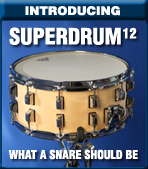


| December 31, 2025 | ||
 |
 |
 |
Lesson One: Lesson Two: The Single Paradiddle and the Five Stroke Roll 34 Additional Rudiments: More Advanced Rudiments Upbeats and Downbeats: Playing with Three Limbs!
|
Drumhead Tuning Tips From REMO
PreparationUsing a dry cloth, wipe any debris from the bearing edge and the counterhoop. Wipe down the inside of the drum.Place a new head on the bearing edge and spin the head to center it. Replace the counterhoop and rods. Finger tighten the rods around the drum.Seating the HeadMost drummers use the standard cross-tune method with one drum key around the drum. That is, the first rod you tension would be number 1 and the rod opposite it would be number 2. Then, 2 rods to the right would be number 3 and the one opposite it would be number 4. Then one rod below number 4 would be number 5 and the one opposite it number six. Then the rod 2 above 5 would be seven and the one opposite it would be 8.You can also use two keys, one opposite the other, tuning 1 and 2, 3 and 4, 5 and 6, 7 and 8 at the same time. Tune the head 1 full turn above the pitch you want at first. With the drum on the floor , place your palm in the center of the head and apply pressure. This seats or stretches the head material, eliminating unwanted slack. De-tune the head to the wrinkle point. Now you are ready to begin tuning.Fine TuningPlace a finger lightly in the center of the head to control overtones. Begin by turning each tuning rod one half turn tighter. When the head is close to the pitch you are after, tap lightly with a stick in front of each tension rod to determine which rod is nearest to the desired pitch. Either tune or de-tune the other tuning rods to match the pitch of the tuning rod you have selected. If the pitch in front of each rod is too low, increase tension on the lower pitched rods. If the average pitch is too high, de-tune the high pitched rods. Continue fine tuning to the desired pitch. Each tuning rod needs to have the same pitch for the drum to be in tune with itself.the Bedrock SoundI like a very tight snare drum with a high pitched pop and lots of articulation. I need to hear alot of snare in the edge because I love to use press rolls. In fact, this is how I evaluate the quality of a snare drum. Any individual drum has a narrow range that it sounds the best in. With toms I like to find a sweet spot in the higher range for the top head and tune the bottom head a little lower. I like the bass drum a little looser for an awesome low end.To see and hear these examples, order Drum Tuning. |
 
| ||
| HOME | FREE DRUM LESSONS | DRUM SHOP | DAVE "BEDROCK" BIO | WORLD’S GREATEST DRUMMERS | STUDENT TESTIMONIALS | ||||